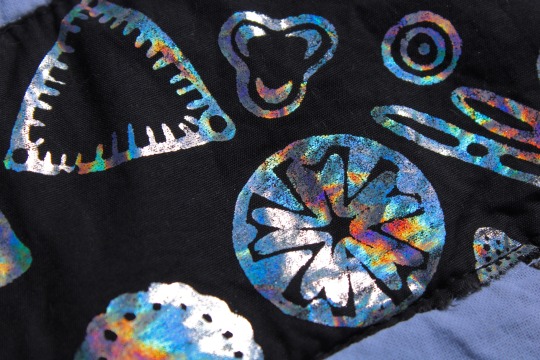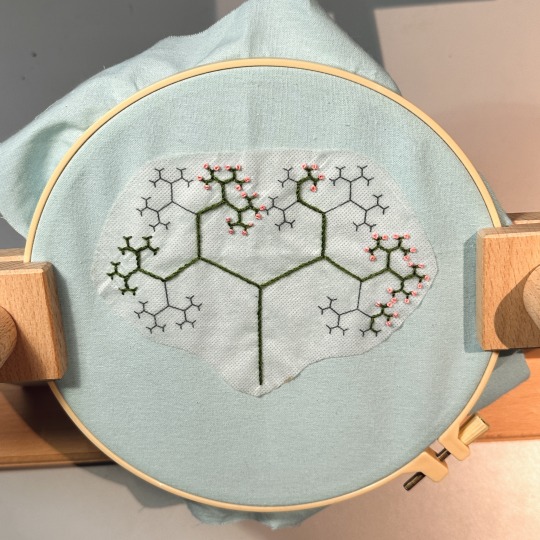#fiber science
Explore tagged Tumblr posts
Text
Higher thread counts are seen as desirable because they make materials softer, and tend to wear better over time – the more strands there are to begin with, the more there will remain to hold the fabric together when some begin to fray.
Zaria Gorvett, The ancient fabric that no one knows how to make
#weaving#textiles#fiber arts#fiber science#zaria gorvett#gorvett#the ancient fabric that no one knows how to make#2021#gorvett 2021#3/16/2021
25 notes
·
View notes
Text

sometimes you just need a little sidekick
beetle embroidery by me, 2025.
#original art#weird art#embroidery#my art#goblincore#bugs#decor#entomology#fiber art#insects#dark academia#cottagecore#nature#science
3K notes
·
View notes
Text



found this abandoned quilt top while cleaning and had to finish it up finally. screen printed and sewn last semester and finally quilted and bound yesterday. using holographic foils to emulate the glassy appearance of diatoms under the microscope, i sewed a log cabin pattern as a playful nod to the idea that diatoms live in tiny glass houses.
Glass Cabin, 2023, 40x42in, pieced cotton with textile foil screenprints, polyester batting, gifted fabric backing
8K notes
·
View notes
Text

Work in progress of a binary tree.
#embroidery#fiber craft#math art#math embroidery#math#craft#mathblr#science craft#yarnblr#threadedtheorems
211 notes
·
View notes
Text
for more exciting science send ice cream
today's discovery is that according to a textiles bulletin from the university of Illinois from like, 1912, you can tell the difference between linen and cotton by dripping oil on the fabric!
Nev: but. fire. Meg: Sometimes you are at a store in 1920 and you can carry a vial of oil but you cannot carry fire.
I hadn't heard of this test before (most fabric tests indeed involve fire on account of the distinctions in how the burned material looks and smells -- or a lab, which is more accurate but also less accessible to a housewife in 1912 squinting suspiciously at a bolt of sale fabric) but I was immediately sure it was accurate, which kind of bothered me because I usually KNOW why I think something is accurate. an hour later --
Meg: wait linen is a bast fiber and cotton is a seed fiber THATS it
TLDR: linen is made from the inner part of the plant and is in long fibers and cotton is made from the seed pod and is in short, fluffy fibers, so of course they'd react to oil differently. Also I have accidentally gotten oil on paper made from other bast fibers and it does indeed go translucent. (Cotton does too but not as dramatically. Something something capillary action?)
126 notes
·
View notes
Text
Bio-based materials may pose a greater health risk to some of the planet's most important species than the conventional plastics they are designed to replace, a new study has shown. Such materials are increasingly being advocated as environmentally friendly alternatives to plastics, and used in textiles and products including clothing, wet wipes and period products. However, microfibres of the materials are emitted into the environment through the laundry cycle, the application of sewage sludge as fertilisers, or the simple wear and tear of textile products. Despite increasing quantities of bio-based products being produced and sold all over the world, there has been little research to assess their potential impact on species and ecosystems.
Read more.
197 notes
·
View notes
Text
5-minute survey about crafts and information/data
Spotted on Reddit:
Hi everyone! I'm a PhD student and a fellow fiber artist myself, and I’m working on conducting a research project that is potentially relevant for some of you! I’d absolutely love to have anyone here who qualifies participate, and please let me know if you have any questions! Thanks! Here’s our whole call for participation: Have you made a fiber arts project (knitting, crocheting, embroidery, sewing, weaving, and many others) that shows or represents information or data? We’re a team of researchers looking for participants for a 5-minute survey where you’ll answer a few questions and upload an image of your completed work. The survey can be completed on any device where you have access to pictures of your work. In the survey, you can decide whether you want your work to be shown as part of the research project and how we attribute it. You can access the survey and more details on the link below. We are also looking to conduct paid follow-up surveys if the work qualifies, so please let us know in the survey if you are interested! This study was reviewed by Northeastern University’s Institutional Review Board as IRB#24-12-27. Even if you’re unsure if your work would be included, we encourage you to participate regardless! We’d like to be as inclusive as possible and see as wide of a range of work as we can, so having lots of examples is very helpful! You can find the link to participate here: https://neu.co1.qualtrics.com/jfe/form/SV_b9hTGsHewAzmfxY Thank you so much! We’re crafters ourselves and looking forward to understanding your work and providing a platform for crafters to share their work broadly!
If you've ever knitted one of those "colour of the sky on each day of the year" scarves, crocheted a "digits of pi" scarf or whatnot, this is for you!

123 notes
·
View notes
Text



my 100% best advice for basically every single one of us to improve mood and overall health is to get >30g dietary fiber from diverse sources every single day, (followed closely by move your body when you can). Above, I have outlined a little bit of why, and a lot of how. In the words of the ancient greeks: food is medicine, yo.
44 notes
·
View notes
Text
✨️Fibre ✨️ Bruja✨️
The Jacquard Loom Device
~ an idea that led to the computer age -
The morning news sent me a thread that took me to a rabbit hole ending in a deep well of philosophy & economics.
First - the article 👇 (take 5 minutes to really read this story of technology loss & salvation.)
There's a lot of threads to untangle here so let's begin with the impact of this device on our collective world history.

Although often called a Jacquard loom it is really a separate piece - the Jacquard Loom Device - attached to a loom that separates this weaving machine from others. It is this device, with its array of connected punch cards, that made complex patterns from binary code.

After all - the warp threads (the shead) are either UP or DOWN in the process of weaving. Up (1) or down (0) - the two choice system is the basic of Binary code.

These looms were once ubiquitous. Today - as with many older tools of hand crafting - they are rare. Their decline is - of course - economic based. It is understandable that the loom & device is no longer feasible as a method of production - - - However, as a method of rendering Art and as historical reference of the computer age - why would a College or University dedicated to the association of Art & Science not find a place for these machines?

This is, quite literally, the technological link between the old & the new world. Discarding the few remaining specimens (because they are truly rare) is akin to having an ancient pyramid dismantled to put in an industrial park. The structure, mechanics, and process of these machines still have lessons to teach and art to make.
#fiber#fiber arts#jacquard#loom Jacquard device#weaving#binary systems#complexity#integrated fields#art & science
22 notes
·
View notes
Text
Scientists in China have synthesized spider silk from genetically modified silkworms, producing fibers six times tougher than the Kevlar used in bulletproof vests. The study, published September 20 in the journal Matter, is the first to successfully produce full-length spider silk proteins using silkworms. The findings demonstrate a technique that could be used to manufacture an environmentally friendly alternative to synthetic commercial fibers such as nylon. "Silkworm silk is presently the only animal silk fiber commercialized on a large scale, with well-established rearing techniques," said Mi. "Consequently, employing genetically modified silkworms to produce spider silk fiber enables low-cost, large-scale commercialization." Scientists have eyed spider silk as an enticingly sustainable alternative to synthetic fibers, which can release harmful microplastics into the environment and are often produced from fossil fuels that generate greenhouse gas emissions. But turning to nature for alternatives isn't without challenges.
Continue Reading
318 notes
·
View notes
Text





Please vote for my scarf here!
#white hare knits#visualizing science contest#scientific knitting#genetic sequencing scarf#extra long scarf#knitting#fiber artist
27 notes
·
View notes
Text

Bisected Sponge, 15x14in, cotton fabrics with glue resist dye treatment, cotton batting and thread
study of an 1800’s era sea sponge illustration on fabric, cut into pieces and rearranged. if interested in this piece please inquire via dm, flexible pricing :)
3K notes
·
View notes
Text

This full binary tree branches out over 8 levels 🌿✨, stitched with stem stitch and dotted with French knot leaves. Who knew recursion could look so cute? Template in my blog description if you want to stitch your own!
#Also PSA that I have a tiktok and youtube now#I'm posting timelapses of making the pieces (starting with this one)#If you want some more maths embroidery on your respective feeds#math#math art#mathblr#embroidery#craft#fibre arts#science craft#yarnblr#fiber craft#math embroidery#threadedtheorems
238 notes
·
View notes
Text

#edamame#they are delicious#but their fiber and nutrition content was accidentally calculated using the entire pod#and I seriously doubt most people eat them that way#for science
12 notes
·
View notes
Text

Scientists revive legendary golden sea silk using Korean pen shell byssus
A luxurious fiber once reserved exclusively for emperors in ancient times has been brought back to life by Korean researchers. A team led by Professor Dong Soo Hwang and Professor Jimin Choi has successfully recreated a golden fiber, akin to that of 2,000 years ago, using the pen shell (Atrina pectinata) cultivated in Korean coastal waters. This breakthrough not only recreates the legendary sea silk but also reveals the scientific basis behind its unchanging golden color. The study was recently published in the journal Advanced Materials. Sea silk—often referred to as the "golden fiber of the sea"—was one of the most prized materials in the ancient Roman period, used exclusively by figures of high authority such as emperors and popes. This precious fiber is made from the byssus threads secreted by Pinna nobilis, a large clam native to the Mediterranean, which uses the threads to anchor itself to rocks.
Read more.
48 notes
·
View notes
Text

cross stitch bookmark of some lavender, made from a kit I bought last weekend !! did you know that lavender is in the lamiaceae family, making it closely related to a bunch of different herbs like mint, catnip, and basil?
18 notes
·
View notes